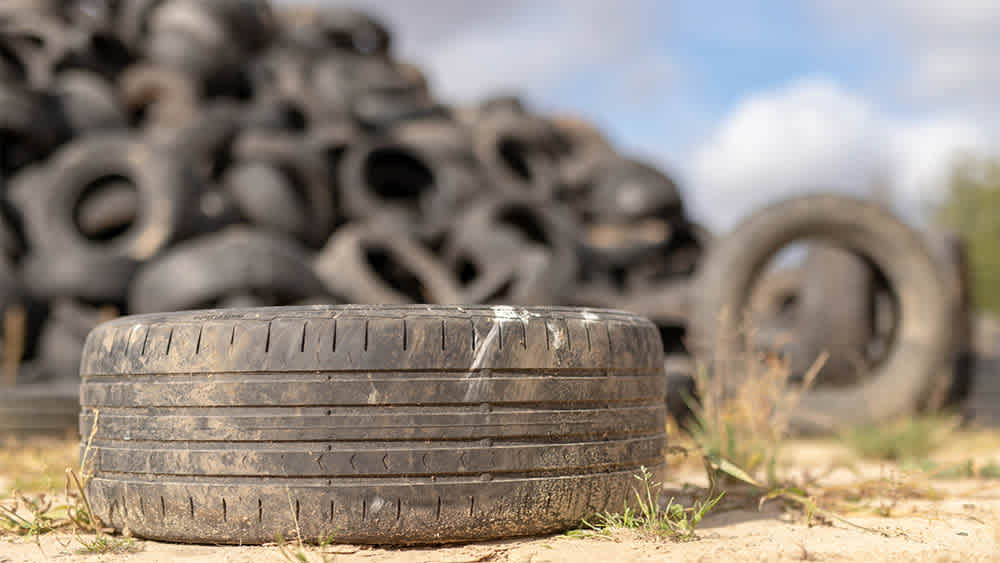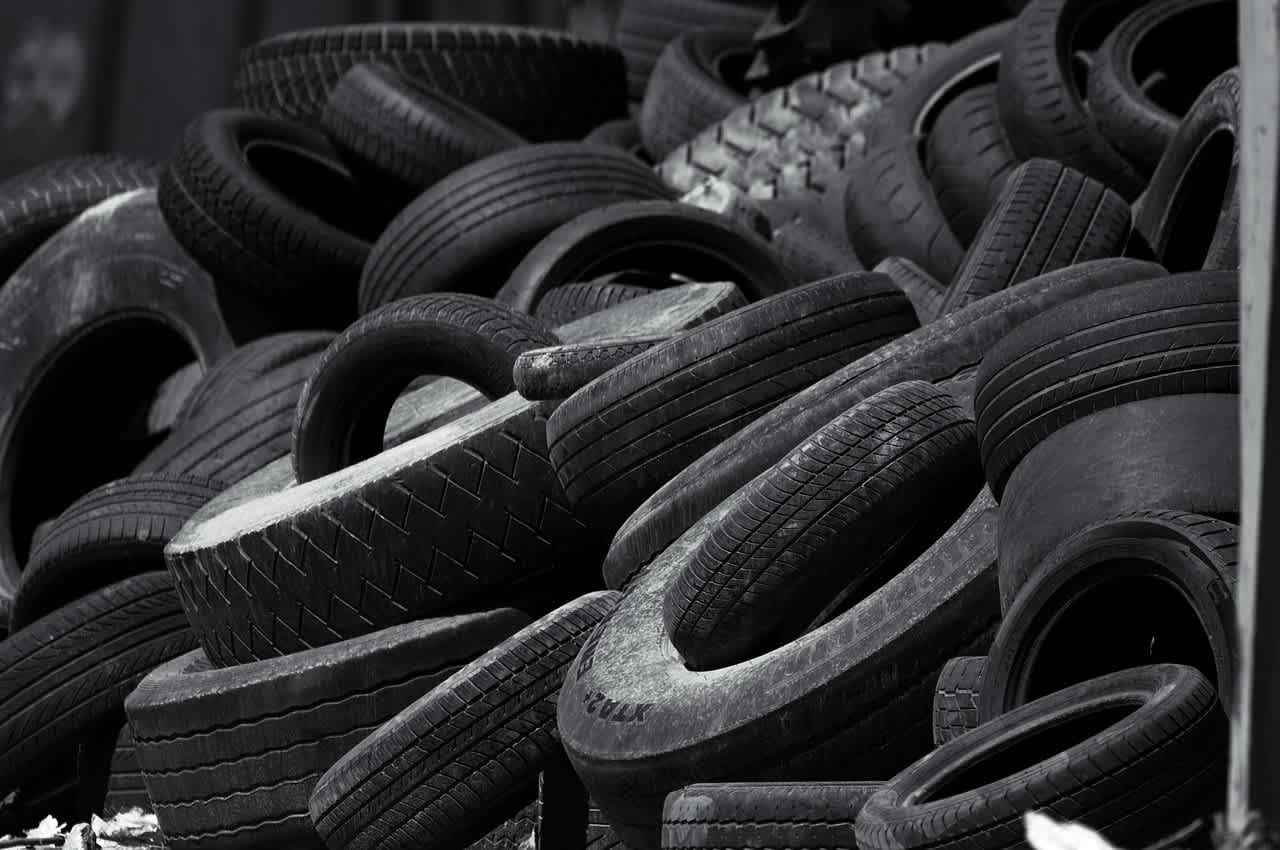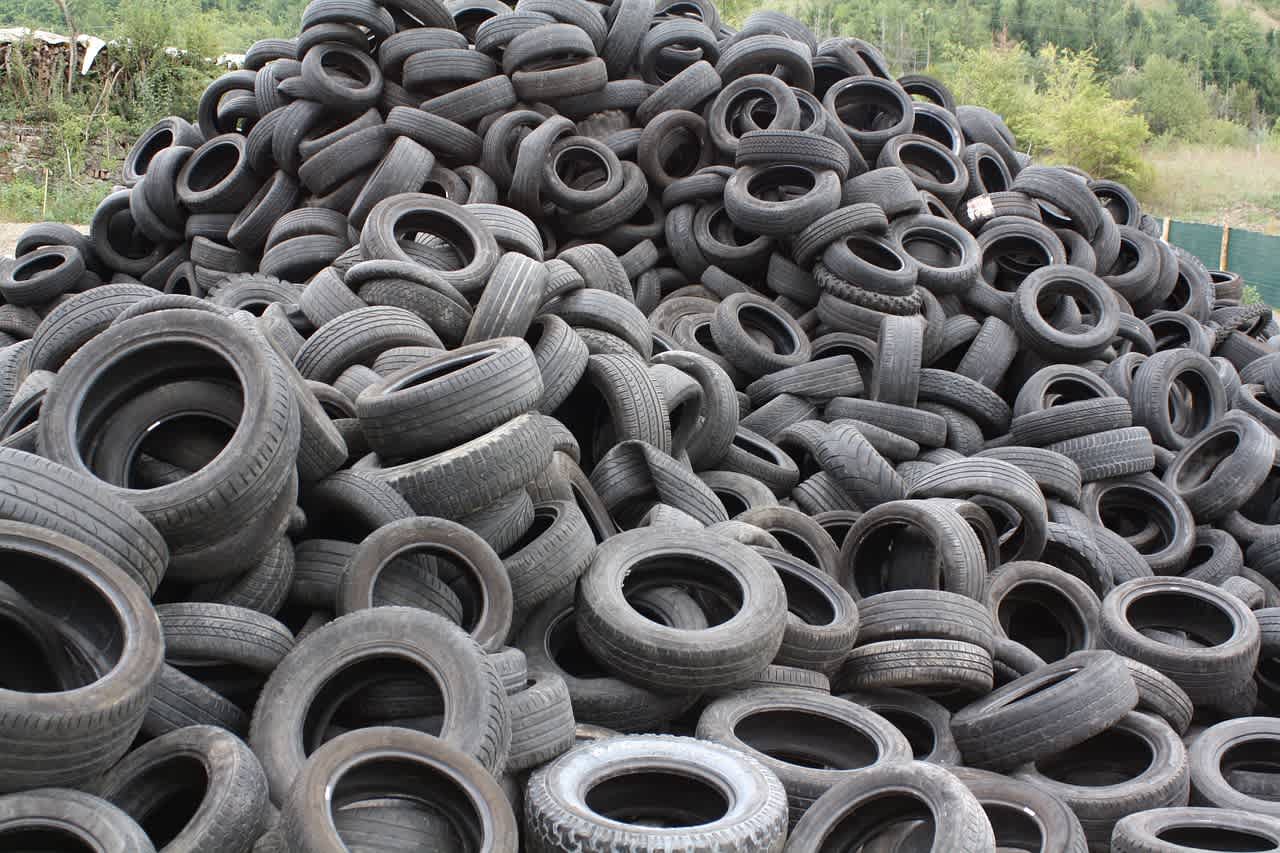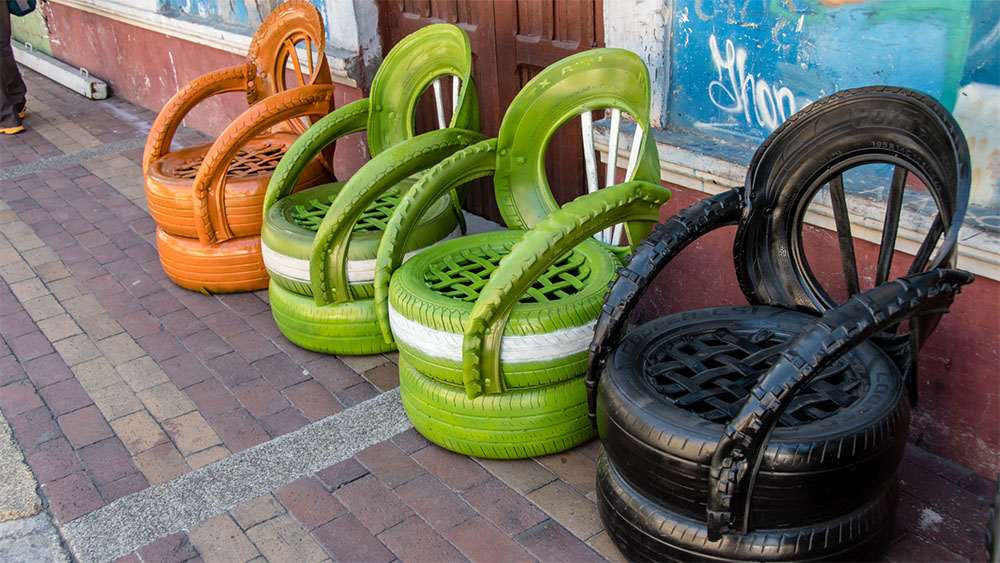Tire News & Information
Free shipping
Best price guarantee
Special pricing
Financing with Resolve
Easy returns

Every year, millions of tires reach the end of their useful life on American roads, creating one of our most challenging waste management issues. These worn-out tires cannot simply disappear into landfills like other waste materials because their unique composition resists natural breakdown for decades.
The sheer volume of tire waste demands attention: approximately 280 million tires are discarded annually across the United States. This mountain of rubber, steel, and synthetic materials requires specialized handling to prevent environmental damage and transform waste into valuable resources.
Modern tire recycling has evolved from a necessity into an opportunity, turning potential environmental hazards into useful products for construction, recreation, and energy production. Understanding this process helps vehicle owners make responsible choices about tire disposal while supporting a growing industry that benefits communities nationwide.
What Is Tire Recycling?

Tire recycling is the process of converting end-of-life tires that are no longer safe for vehicles into valuable materials and products. When tires wear down to unsafe tread depths or suffer irreparable damage, they enter a sophisticated recycling system designed to extract maximum value from every component. This process addresses a critical environmental need: tires are engineered to withstand years of punishment on the road, which means they resist natural decomposition when discarded.
Old tires cannot break down naturally and take up massive space in landfills, making recycling essential for environmental protection. A single passenger tire occupies approximately 75% void space, creating inefficient use of landfill capacity. The synthetic rubber compounds, reinforced with steel belts and polyester cords, can persist in the environment for centuries without proper processing.
The process involves collecting, processing, and transforming used tires into new materials like rubber mulch, playground surfaces, and fuel. Professional recycling facilities employ specialized equipment to separate the various tire components — rubber, steel, and fabric — before processing each material stream for specific end uses. This systematic approach ensures that virtually every part of a tire finds new purpose rather than contributing to waste accumulation.
Each year, Americans discard approximately 280 million tires — that's about one tire per person. This staggering volume represents over 5.6 million tons of material, with passenger car tires accounting for 65% of the total, light truck and SUV tires contributing 25%, and commercial truck tires making up 8%. The remaining 2% consists of specialty tires for motorcycles, aircraft, and industrial equipment.
Unlike other materials, tires are made from synthetic rubber, steel, and fabric that require special recycling methods to break down properly. The vulcanization process that gives tires their durability also makes them resistant to conventional recycling techniques. Modern facilities use two primary processing methods: ambient mechanical grinding at room temperature and cryogenic processing that freezes tires with liquid nitrogen before shattering them into small particles. Both methods produce different grades of recycled rubber suitable for various applications, from athletic surfaces to industrial products.
Why Is Tire Recycling Important for the Environment?
Discarded tires create environmental challenges when improperly disposed of. In landfills, they can accumulate gases like methane, leading to structural issues that compromise landfill safety. This not only poses environmental hazards but also increases the risk of greenhouse gas emissions.
Abandoned tire piles offer breeding grounds for pests. In warm areas, water trapped in tires attracts mosquitoes, contributing to the spread of diseases. Moreover, these piles are fire hazards, capable of burning for extended periods and releasing harmful pollutants. Such fires result in significant air and water quality issues.
Recycling addresses these concerns by significantly reducing tire waste. By transforming scrap tires into valuable materials, the industry supports environmental sustainability. Historical efforts have cut down illegal stockpiles dramatically, from over a billion in the early '90s to much lower numbers today, highlighting the progress achieved through responsible recycling practices.
How Does the Tire Recycling Process Work?

Collection and Transportation
The tire recycling journey starts by gathering discarded tires from various locations, such as auto shops and disposal centers. States often host events where people can drop off tires without charge, encouraging community participation in recycling efforts. This proactive approach reduces the risk of illegal dumping and supports environmental initiatives.
Specialized transport systems play a crucial role in moving these tires to recycling facilities. Designed for efficiency, these systems ensure tires are delivered intact, ready for further processing. This step lays the groundwork for the successful transformation of waste into valuable materials.
Processing Methods
Upon arrival, tires undergo an inspection to remove any metal, fabric, or debris, ensuring the purity of the rubber. This careful preparation is essential to maintain high-quality output.
Advanced machinery then cuts the tires into smaller chunks, preparing them for the next stage. Two key methods—ambient grinding and cryogenic processing—are employed. Ambient grinding reduces the tire material at standard temperatures, while the cryogenic method involves freezing tires to make them brittle before breaking them into finer particles.
Steel components within the tires are extracted using magnetic technology, ensuring that only rubber progresses through the system. The rubber is then meticulously cleaned and screened to remove any remaining impurities, resulting in crumb rubber and rubber powder, ready for new applications.
What Products Are Made From Recycled Tires?
Construction and Infrastructure
Recycled tires are pivotal in modern construction, transforming waste into valuable building materials. Roads benefit from rubber-modified asphalt, which enhances durability and reduces traffic noise. This innovative use improves urban living conditions by addressing noise pollution.
Tire-derived aggregate (TDA) provides an effective solution for stabilizing embankments and improving drainage systems. Its lightweight nature aids in construction efficiency and cost-effectiveness. TDA also excels in preventing erosion, ensuring long-term structural integrity in infrastructure projects.
In retaining wall applications, recycled tire materials offer significant weight reduction. This feature eases construction demands while maintaining robust support, making it a practical choice for engineers and builders.
Consumer Products

Recycled tire materials contribute significantly to consumer goods, offering sustainable alternatives that perform exceptionally well. Playground surfaces crafted from recycled rubber provide a safe environment for children, absorbing impacts and minimizing injury risks. Rubber mulch enhances gardens by retaining moisture and controlling weed growth.
Athletic tracks and synthetic turf fields incorporate recycled materials to deliver durable, high-performance surfaces. These products are essential for sports facilities, providing longevity and reducing maintenance needs.
Additional consumer items include durable floor mats, chairs, speed bumps, and parking stops. In agriculture, livestock mats and irrigation-friendly barriers utilize recycled rubber, supporting eco-friendly farming practices.
Energy Applications
Recycled tires serve as a crucial alternative energy source through tire-derived fuel (TDF). This efficient fuel powers cement kilns and industrial plants, offering a cleaner alternative to traditional coal and reducing harmful emissions.
In paper mills and manufacturing settings, TDF replaces conventional fuels, enhancing energy efficiency and reducing costs. This shift not only supports environmental goals but also contributes to economic sustainability in industrial operations.
What Are the Benefits of Recycling Tires?

Environmental Benefits
Recycling tires significantly contributes to environmental preservation by keeping them out of landfills, which conserves space for other non-recyclable waste. This helps maintain ecological balance and minimizes environmental disruption. By processing tires into new materials, we also reduce the need for fresh resources, supporting a more sustainable approach to consumption.
The recycling process mitigates the threat of tire fires, which can release toxic pollutants into the air and harm ecosystems. By transforming tires into reusable products, the risk of these fires decreases, promoting cleaner air and safer habitats. Additionally, recycling prevents potential soil and water contamination, ensuring healthier natural surroundings.
Economic Benefits
The tire recycling industry fosters economic growth by generating employment in sectors like collection, processing, and manufacturing. These roles support local economies and provide essential skills. Businesses experience cost savings by integrating recycled materials into their production processes, as these materials often come at a lower price than new resources.
Recycled products create additional revenue streams, enhancing economic stability. Communities benefit financially by reducing the burden on waste management systems, cutting expenses linked to landfill upkeep and disposal. This financial efficiency helps fund other community development projects.
Community Benefits
Recycling tires improves community environments by reducing areas where pests can thrive, enhancing public health and safety. Cleaner surroundings result from diminished illegal dumping in natural spaces, promoting a sense of community pride.
Moreover, recycled materials support local projects, such as playgrounds, encouraging community engagement and providing recreational spaces. These initiatives foster stronger community connections and inspire ongoing participation in sustainable practices.
Where Can You Recycle Tires?
Local Options
Recycling tires effectively begins with finding nearby solutions. Many tire retailers offer recycling services as part of a new tire purchase, making it easy to dispose of old ones. These services help ensure tires are recycled correctly. Additionally, searching online for facilities in your area can direct you to specialized centers. Many communities also host designated drop-off days, providing a straightforward option for tire disposal in collaboration with environmental agencies.
Costs and Fees
When purchasing new tires, expect to pay a small fee—typically between $0.50 and $2.00 per tire—to support recycling initiatives. This fee contributes to statewide programs that facilitate proper tire management. Some recycling centers may charge a nominal fee for tire drop-off to cover processing costs. Free collection events offer an alternative, though they might have restrictions on the number of tires you can bring at once.
What to Know Before Recycling
Proper preparation ensures a smooth recycling experience. Remove rims before dropping off tires to simplify handling. Confirm that the recycling center accepts the specific type of tire you have, whether it's for a car, truck, or specialty vehicle. Ask about any specific requirements for preparation, such as cleaning. Keeping tires dry and separate from other waste ensures they are ready for recycling.
How to Support Tire Recycling Efforts
Supporting tire recycling begins with choosing eco-friendly products. Consider items made from recycled materials, such as rubberized asphalt for driveways or athletic tracks. These choices help sustain the demand for recycled goods and promote environmental responsibility.
Extend the life of your tires by ensuring they are properly inflated and balanced. This not only enhances performance but also reduces the frequency of replacements. By maximizing tire longevity, you contribute to waste reduction and improve your vehicle's efficiency.
Partner with retailers that prioritize recycling initiatives. When you buy new tires, check if the retailer offers to take back and recycle your old tires. This supports a closed-loop system in the tire industry, minimizing environmental impact.
Dispose of tires responsibly by using designated drop-off points or participating in local collection events. These methods ensure tires are processed correctly, preventing environmental damage. Avoid illegal dumping to protect natural habitats and community spaces.
Support organizations and projects that utilize recycled tire products. Whether it's infrastructure improvements using tire-derived aggregate or community playgrounds, your involvement boosts sustainable practices. This participation aids in creating a market for recycled materials.
Raise awareness about the importance of recycling tires among friends and family. Sharing information on the benefits of recycling encourages collective action. Together, these efforts contribute to a cleaner environment and a sustainable future.
As you consider your next tire purchase, remember that responsible disposal of your old tires plays a crucial role in protecting our environment and supporting sustainable practices. By choosing proper recycling methods and understanding the value of tire recycling, you help transform potential waste into valuable resources for communities nationwide.
When it's time to replace your worn tires, we make it easy to shop for tires online and find the best deals while keeping sustainability in mind.
Ready to find the perfect tires?
Search By